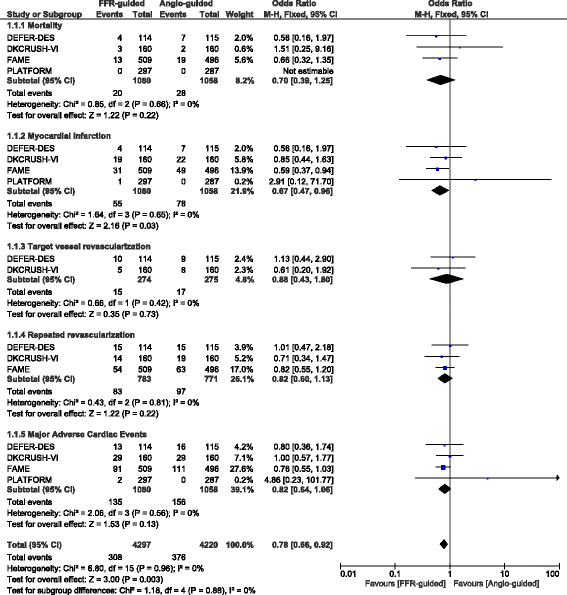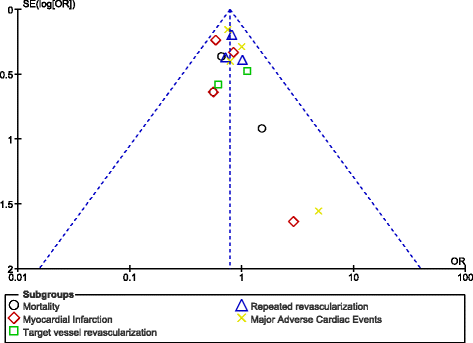Comparing the adverse clinical outcomes associated with fraction flow reserve-guided versus angiography-guided percutaneous coronary intervention: a systematic review and meta-analysis of randomized controlled trials
- PMID: 27912739
- PMCID: PMC5135818
- DOI: 10.1186/s12872-016-0427-8
Comparing the adverse clinical outcomes associated with fraction flow reserve-guided versus angiography-guided percutaneous coronary intervention: a systematic review and meta-analysis of randomized controlled trials
Abstract
Background: Recently published randomized controlled trials have shown different results compared to the Fraction Flow Reserve Versus Angiography for Multi-vessel Evaluation (FAME) study. Therefore, this current analysis aimed to compare the adverse clinical outcomes associated with Fraction Flow Reserve (FFR)-guided versus standard angiography-guided Percutaneous Coronary Intervention (PCI) using a large number of randomized patients.
Methods: PubMed/Medline, EMBASE and the Cochrane library were searched for studies comparing FFR-guided with angiography-guided PCI. Mortality, Myocardial Infarction (MI), repeated revascularization and Major Adverse Cardiac Events (MACEs) at any follow up period following PCI were considered as the clinical endpoints in this analysis. Odds Ratios (OR) with 95% Confidence Intervals (CIs) were calculated and the analyses were carried out by the RevMan 5.3 software. Ethical approval was not necessary for this type of study.
Results: A total number of 2138 patients (1080 patients with FFR-guided versus 1058 patients with angiography-guided PCI) were included. Results of this analysis showed mortality not to be significantly different between FFR-guided and angiography-guided PCI with OR: 0.70, 95% CI: 0.39 - 1.25; P = 0.22, I2 = 0%. Total repeated revascularization and Target Lesion Revascularization were also similarly manifested with OR: 0.82, 95% CI: 0.60 - 1.13; P = 0.22, I2 = 0% and OR: 0.88, 95% CI: 0.43 - 1.80; P = 0.73, I2 = 0% respectively. In addition, MACEs were also not significantly lower in the FFR-guided PCI group with OR: 0.82, 95% CI: 0.64 - 1.06; P = 0.13, I2 = 0%. However, FFR-guided PCI was associated with a significantly lower rate of re-infarction with OR: 0.67, 95% CI: 0.47 - 0.96; P = 0.03, I2 = 0%.
Conclusion: FFR-guided PCI was not associated with significantly higher adverse clinical outcomes when compared to angiography-guided PCI. A significantly lower rate of re-infarction associated with FFR-guided PCI could show an important benefit. However, due to the limited number of patients analyzed, this hypothesis should further be confirmed in future trials.
Keywords: Fraction flow reserve; Major adverse cardiac events; Myocardial infarction; Percutaneous coronary intervention.
Figures
References
-
- Pijls NH, Fearon WF, Tonino PA, et al. FAME study investigators. Fractional flow reserve versus angiography for guiding percutaneous coronary intervention in patients with multivessel coronary artery disease: 2-year follow-up of the FAME (Fractional Flow Reserve VersusAngiography for Multivessel Evaluation) study. J Am Coll Cardiol. 2010;56(3):177–84. doi: 10.1016/j.jacc.2010.04.012. - DOI - PubMed
Publication types
MeSH terms
LinkOut - more resources
Full Text Sources
Other Literature Sources
Medical
Miscellaneous




